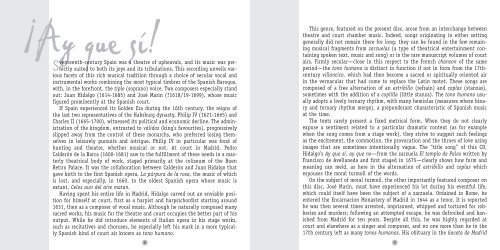You also want an ePaper? Increase the reach of your titles
YUMPU automatically turns print PDFs into web optimized ePapers that Google loves.
S¡Ay que sí!venteenth-century Spain was a theatre of upheavals, and its music was perfectlysuited to both its joys and its tribulations. This recording unveils variousfacets of this rich musical tradition through a choice of secular vocal andinstrumental works combining the most typical timbres of the Spanish Baroque,with, in the forefront, the tiple (soprano) voice. Two composers especially standout: Juan Hidalgo (1614-1685) and José Marín (?1618/19-1699), whose musicfigured prominently at the Spanish court.If Spain experienced its Golden Era during the 16th century, the reigns ofthe last two representatives of the Habsburg dynasty, Philip IV (1621-1665) andCharles II (1665-1700), witnessed its political and economic decline. The administrationof the kingdom, entrusted to válidos (king’s favourites), progressivelyslipped away from the control of these monarchs, who preferred losing themselvesin leisurely pursuits and intrigue. Philip IV in particular was fond ofhunting and theatre, whether musical or not. At court in Madrid, PedroCalderón de la Barca (1600-1681) saw to the fulfillment of these needs in a masterlytheatrical body of work, staged primarily at the coliseum of the BuenRetiro Palace. It was the collaboration between Calderón and Juan Hidalgo thatgave birth to the first Spanish opera, La púrpura de la rosa, the music of whichis lost, and especially, in 1660, to the oldest Spanish opera whose music isextant, Celos aun del aire matan.Having spent his entire life in Madrid, Hidalgo carved out an enviable positionfor himself at court, first as a harpist and harpsichordist starting around1631, then as a composer of vocal music. Although he naturally composed manysacred works, his music for the theatre and court occupies the better part of hisoutput. While he did introduce elements of Italian opera in his stage works,such as recitatives and choruses, he especially left his mark in a more typicallySpanish kind of court air known as tono humano.8This genre, featured on the present disc, arose from an interchange betweentheatre and court chamber music. Indeed, songs originating in either settinggenerally did not remain there for long; they can be found in the few remainingmusical fragments from zarzuelas (a type of theatrical entertainment containingspoken text, music and song) or in the rare manuscript volumes of courtairs. Firmly secular—close in this respect to the French chanson of the sameperiod—the tono humano is distinct in function if not in form from the 17thcenturyvillancico, which had then become a sacred or spiritually oriented airin the vernacular that had come to replace the Latin motet. These songs arecomposed of a free alternation of an estribillo (refrain) and coplas (stanzas),sometimes with the addition of a coplilla (little stanza). The tono humano usuallyadopts a lively ternary rhythm, with many hemiolas (measures where binaryand ternary rhythm merge), a preponderant characteristic of Spanish musicat the time.The texts rarely present a fixed metrical form. When they do not clearlyexpose a sentiment related to a particular dramatic context (as for examplewhen the song comes from a stage work), they strive to suggest such feelingsas the excitement, the commotion, the provocation and the throes of love usingimages that are sometimes intentionally vague. The “title song” of this CD,Hidalgo’s Ay que sí, ay que no—from the zarzuela El templo de Palas written byFrancisco de Avellaneda and first staged in 1675—clearly shows how form andmeaning can meld, as here in the alternation of estribillo and coplas whichespouses the moral turmoil of the words.On the subject of moral turmoil, the other importantly featured composer onthis disc, José Marín, must have experienced his lot during his eventful life,which could itself have been the subject of a zarzuela. Ordained in Rome, heentered the Encarnacíon Monastery of Madrid in 1644 as a tenor. It is reportedhe was then several times arrested, imprisoned, whipped and tortured for robberiesand murders; following an attempted escape, he was defrocked and banishedfrom Madrid for ten years. Despite all this, he was highly regarded atcourt and elsewhere as a singer and composer, and no one more than he in the17th century left as many tonos humanos. His obituary in the Gaceta de Madrid9
















